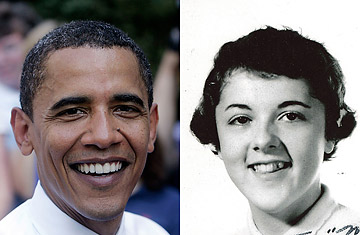
(4 of 4)
Ann's most lasting professional legacy was to help build the microfinance program in Indonesia, which she did from 1988 to '92--before the practice of granting tiny loans to credit-poor entrepreneurs was an established success story. Her anthropological research into how real people worked helped inform the policies set by the Bank Rakyat Indonesia, says Patten, an economist who worked there. "I would say her work had a lot to do with the success of the program," he says. Today Indonesia's microfinance program is No. 1 in the world in terms of savers, with 31 million members, according to Microfinance Information eXchange Inc., a microfinance-tracking outfit.
While his mother was helping poor people in Indonesia, Obama was trying to do something similar 7,000 miles (about 11,300 km) away in Chicago, as a community organizer. Ann's friends say she was delighted by his career move and started every conversation with an update of her children's lives. "All of us knew where Barack was going to school. All of us knew how brilliant he was," remembers Ann's friend Georgia McCauley.
Every so often, Ann would leave Indonesia to live in Hawaii--or New York or even, in the mid-1980s, Pakistan, for a microfinance job. She and her daughter sometimes lived in garage apartments and spare rooms of friends. She collected treasures from her travels--exquisite things with stories she understood. Antique daggers with an odd number of curves, as required by Javanese tradition; unusual batiks; rice-paddy hats. Before returning to Hawaii in 1984, Ann wrote her friend Dewey that she and her daughter would "probably need a camel caravan and an elephant or two to load all our bags on the plane, and I'm sure you don't want to see all those airline agents weeping and rending their garments." At his house in Chicago, Obama says, he has his mother's arrowhead collection from Kansas--along with "trunks full of batiks that we don't really know what to do with."
In 1992, Obama's mother finally finished her Ph.D. dissertation, which she had worked on, between jobs, for almost two decades. The thesis is 1,000 pages, a meticulous analysis of peasant blacksmithing in Indonesia. The glossary, which she describes as "far from complete," is 24 pages. She dedicated the tome to her mother; to Dewey, her adviser; "and to Barack and Maya, who seldom complained when their mother was in the field."
In the fall of 1994, Ann was having dinner at her friend Patten's house in Jakarta when she felt a pain in her stomach. A local doctor diagnosed indigestion. When Ann returned to Hawaii several months later, she learned it was ovarian and uterine cancer. She died on Nov. 7, 1995, at 52.
Before her death, Ann read a draft of her son's memoir, which is almost entirely about his father. Some of her friends were surprised at the focus, but she didn't seem obviously bothered. "She never complained about it," says Peluso. "She just said it was something he had to work out." Neither Ann nor her son knew how little time they had left.
Obama has said his biggest mistake was not being at his mother's side when she died. He went to Hawaii to help the family scatter the ashes over the Pacific. And he carries on her spirit in his campaign. "When Barack smiles," says Peluso, "there's just a certain Ann look. He lights up in a particular way that she did."
After Ann's death, her daughter dug through her artifacts, searching for Ann's story. "She always did want to write a memoir," Soetoro-Ng says. Finally, she discovered the start of a life story, but it was less than two pages. She never found anything more. Maybe Ann had run out of time, or maybe the chemotherapy had worn her out. "I don't know. Maybe she felt overwhelmed," says Soetoro-Ng, "because there was so much to tell."
